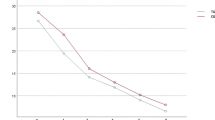Abstract
In a 6-week study the efficacy of combined treatment of imipramine plus mianserin was compared to combined treatment of desipramine plus mianserin in patients with post-stroke depression. Patients were required to have a minimum baseline total score of 15 on the 17-item Hamilton Depression Scale (HAMD). The Melancholia Scale (MES) was also used to measure severity of depressive states to show that somatic symptoms had little influence on the evaluation of depression. Out of 120 stroke patients screened, 20 patients fulfilled the inclusion criteria. The doses of the drugs were flexible, using side-effects as a guide during treatment. Both intention to treat analysis and efficacy data (excluding patients who had dropped out during the first 2 weeks of treatment) showed that imipramine (mean dose 75 mg daily) plus mianserin (mean dose 25 mg daily) was superior to desipramine (mean dose 66 mg daily) plus mianserin (27 mg daily). The MES was found to be more sensitive than the HAMD for measuring change in depressive states during treatment. The assessment of side-effects using the UKU scale showed good tolerance in general. The only difference between the two treatment groups was seen in micturition disturbances, where the imipramine treated patients had most complaints after 14 days of treatment, but the symptoms disappeared despite continuous treatment.
Similar content being viewed by others
References
Bech P (1989) Clinical effects of selective serotonin reuptake inhibitors. In: Dahl SG, Gram LF (eds) Clinical pharmacology in psychiatry. Springer, Berlin, Heidelberg New York pp 81–93
Bech P (1993) Rating scales for psychopathology, health status and quality of life. A compendium on documentation in accordance with DSM-III-R and the WHO systems. Springer, Berlin, Heidelberg New York
Bech P, Kastrup M, Rafaelsen O-J (1986) Mini-compendium of rating scales for states of anxiety, depression, mania, schizophrenia with corresponding DSM-III syndromes. Acta Psychiatr Scand 73 [suppl 326]:7–37
Carney MWP, Roth M, Garside RF (1965) The diagnosis of depressive syndromes and prediction of ECT response. Br J Psychiatry 111:659–674
Charaton FB, Fisk A (1979) Mental and emotional results after stroke. N Y State Med J 78:1403–1405
Danish University Antidepressant Group (DUAG) (1990) Paroxetine: a selective serotonin reuptake inhibitor showing better tolerance but weaker antidepressant effect than clomipramine in a controlled multicenter study. J Affective Disord 18:280–299
House A, Dennis M, Warlow C, Hawton K, Molyneux A (1990) Mood disorders after stroke and their relation to lesion location. Brain 113:1113–1129
Kragh-Sørensen P, Gjerris A (1991) The present state of pharmacotherapy in depression. In: Kragh-Sørensen P, Gjerris A, Bolwig TG (eds) Depression: new trends in research and treatment. Munksgaard, Copenhagen, pp 77–109
Lauritzen L, Clemmesen L, Klysner R, Loldrup D, Lunde M, Schaumburg E, Waarst S, Bech P (1992) Combined treatment with imipramine and mianserin. Pharmacopsychiatry 25:182–186
Lingjærde O, Ahlfors UG, Bech P, Dencker SJ, Elgen K (1987) The UKU side-effect rating scale. Acta Psychiatr Scand 76 [suppl 334]:1–100
Lipsey JR, Robinson RG, Pearlson GD, Rav K, Price TR (1984) Nortriptyline treatment of post-stroke depression: a double-blind study. Lancet i:297–300
Loldrup D, Langemark M, Hansen HJ, Kastrup M, Jeppesen K, Bonnevie O, Elsborg L, Olesen J, Bech P (1991) The validity of the Melancholia Scale (MES) in predicting outcome of antidepressants in chronic idiopathic pain disorders. Eur Psychiatr 6:119–125
Mayeux R (1990) The serotonin hypothesis for depression in Parkinson's disease. In: Streifler MB, Korczyn AD, Melamer E, Youdin MBH (eds) Advances in neurology Raven New York, pp 163–166
Meyberg HS, Robinson RG, Wong DF, Parikh R, Bolduc P, Starkstein SE, Price T, Dannals RF, Links JM, Wilson AA, Ravert HT, Wagner HN (1988) PET imaging of cortical S2 serotonin receptors after stroke: lateralized changes and relationship to depression. Am J Psychiatry 145:937–943
Pocock SJ (1983) Clinical trials Wiley, Chichester
Robinson RG, Starr LB, Kubes KL, Price TR (1983) A two-year longitudinal study of post-stroke mood disorders: findings during the initial evaluation. Stroke 14:736–741
Rodin G, Craven J, Littlefield C (1991) Depression in the medically ill. An integrated approach. Brunner/Mazel, New York
Turner RJ, Beiser M (1990) Major depression and depressive symptomatology among the physically disabled. Assessing the role of chronic stress. J Nerv Ment Dis 178:343–350
Wade DT, Legh-Smith J, Hewer RL (1987) Depressed mood after stroke: a community study of its frequency. Br J Psychiatry 151:200–205
Author information
Authors and Affiliations
Rights and permissions
About this article
Cite this article
Lauritzen, L., Bendsen, B.B., Vilmar, T. et al. Post-stroke depression: combined treatment with imipramine or desipramine and mianserin. Psychopharmacology 114, 119–122 (1994). https://doi.org/10.1007/BF02245452
Received:
Revised:
Issue Date:
DOI: https://doi.org/10.1007/BF02245452



